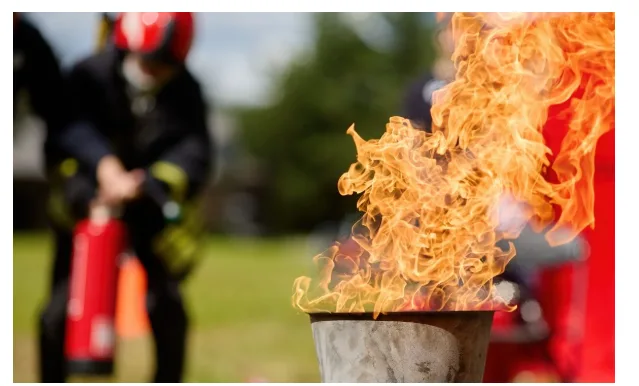How Workplace Fire Safety Training Can Save Lives
Workplace fire safety is a critical concern that can have life-altering consequences. When fires strike, they can lead to severe injuries, loss of life, and significant property damage. This is why understanding fire safety in the workplace is not just beneficial, but essential. Fire safety training acts as a proactive measure, preparing employees to handle potential fire hazards effectively and minimizing risks.
By implementing robust fire safety measures, companies can create a safer environment for their employees. When everyone on staff understands the importance of fire safety training, the collective knowledge serves as the first line of defense in the event of a fire. This training empowers employees to react quickly, efficiently, and safely, making it an integral part of workplace safety culture.
Understanding Workplace Fire Safety Training
Workplace fire safety training involves a comprehensive approach to preventing and responding to fires. This training covers several essential components, all designed to enhance safety awareness and preparedness:
- Evacuation Procedures: Employees learn the safest routes to exit a building in case of a fire, helping to ensure a swift evacuation.
- Fire Prevention Techniques: These techniques educate staff on identifying potential fire hazards and implementing measures to prevent them. You can learn more in this detailed article.
- Use of Fire Extinguishers: Proper training on handling fire extinguishers can enable employees to tackle small flames efficiently.
Structured training is a pivotal element of fire safety, ensuring that employees are well-versed in emergency protocols and prevention strategies. It is important to note that training must be comprehensive, covering both prevention and response aspects to maximize its effectiveness.
Through understanding and participation, employees become key players in sustaining a fire-safe workplace. As they learn to take personal responsibility for safety, they contribute significantly to the overall security and well-being of the workplace environment. This comprehensive training not only meets regulatory standards but also cultivates a proactive safety culture within the organization.
Key Elements of Fire & Safety Training
Effective fire and safety training covers several key elements, ensuring comprehensive understanding and preparedness:
- Identifying Fire Hazards
- Learn to spot potential fire hazards in the workplace.
- Implement measures to minimize risks, such as proper storage of flammable materials.
- Proper Use of Fire Extinguishers
- Training on the correct type and use of fire extinguishers.
- Regular practice helps employees feel confident in using fire extinguishers effectively.
- Developing Emergency Evacuation Plans
- Create clear, actionable evacuation plans tailored to your workplace.
- Train employees on these plans so they know exit routes and assembly points during a fire.
- Conducting and Participating in Fire Drills
- Regular fire drills ensure employees are familiar with emergency procedures.
- Drills simulate real-life scenarios, helping pinpoint areas for improvement.
Investing in thorough training can be the difference between chaos and calm in an emergency. Consult with experts such as Ally Safety.
Fire Response Training and Procedures
Being prepared for a fire in the workplace is crucial. Fire response training equips employees with the knowledge and skills needed to act quickly and safely during such an event. Here are some key steps and components of effective fire response training:
- Recognize Fire Alarms: Train employees to recognize various types of fire alarms and signals. Quick identification can make a significant difference in response time.
- Communicate Effectively: Encourage clear communication during an emergency. Use designated channels or signals to ensure everyone receives the necessary information without confusion.
- Follow Evacuation Routes: Employees should be familiar with all exit routes and assembly points. Regularly review evacuation maps and conduct walkthroughs to reinforce knowledge.
- Use Fire Extinguishers Correctly: Not everyone knows how to use a fire extinguisher. Demonstrations and guided practice sessions can prepare employees to operate extinguishers confidently. You can learn more in this in-depth guide.
- Conduct Regular Drills: Drills simulate real fire situations, allowing employees to practice their response in a controlled environment. Conducting these regularly helps employees react calmly and effectively in real emergencies.
- Simulations and Role Playing: Enhancing traditional drills with simulations or role-play scenarios can improve readiness. These exercises help employees understand different fire situations and adapt accordingly.
Role of a Fire Prevention Officer
A fire prevention officer plays a pivotal role in ensuring workplace safety and mitigating fire risks. This position involves several critical responsibilities:
- Conduct Safety Inspections: Regular inspections of the workplace to identify potential fire hazards are essential. Fire prevention officers assess equipment, electrical systems, and storage practices to ensure compliance with safety standards.
- Implement Fire Safety Policies: Develop and enforce clear fire safety policies that all employees must follow. This includes guidelines on smoking areas, flammable materials storage, and emergency protocols.
- Coordinate with Emergency Services: Maintain communication with local fire departments and emergency services. This coordination ensures a swift response if external support is required during an incident.
- Educate and Train Staff: Organize training sessions and workshops for employees, covering fire prevention, response, and safety compliance. A knowledgeable workforce is a safer one.
- Develop Emergency Plans: Work with management to create detailed emergency response plans. Ensure these plans are accessible and understood by all employees.
- Monitor Compliance: Regularly review and update fire safety procedures and ensure the organization complies with local fire safety regulations.
Incorporating the guidance of a fire prevention officer, businesses can strengthen their fire & safety training strategies.
Advanced Fire Safety Training for Specific Industries
Certain industries face unique risks that require specialized fire safety training. For example, chemical plants, factories, and oil refineries have distinct hazards that standard training programs may not fully address. Here’s why specialized training is essential:
- Chemical Plants: Employees must understand the specific chemicals they work with, their flammability, and how to safely handle them. Proper training includes knowing how to manage chemical spills and appropriate use of fire suppression systems.
- Factories: Machinery and electrical equipment present fire risks. Training involves recognizing electrical hazards and ensuring equipment is maintained to prevent fires.
- Oil Refineries: With vast amounts of flammable materials, workers need in-depth knowledge about fire prevention measures and the types of extinguishers suitable for different fire classes.
These industries often develop tailored training programs to address their unique challenges.
How Proper Training Saves Lives
The impact of thorough fire safety training is profound, significantly reducing injuries and fatalities. Here are some compelling reasons why it is so effective:
- Statistics Show Impact: Studies reveal that workplaces with regular fire safety training see fewer fire-related incidents. By increasing awareness and readiness, employees respond effectively, minimizing harm.
- Real-Life Examples: Several companies have successfully implemented training interventions, leading to safer work environments. For example, a manufacturing plant in Texas saw a 50% reduction in fire incidents after updating their fire safety protocols.
- Tangible Benefits: Effective training programs empower employees with the knowledge to act swiftly during emergencies, resulting in quick evacuations and controlled situations.
By understanding these elements, businesses can assess their current fire safety protocols and identify opportunities for improvement, ensuring that their employees are always prepared to handle fire emergencies safely.






